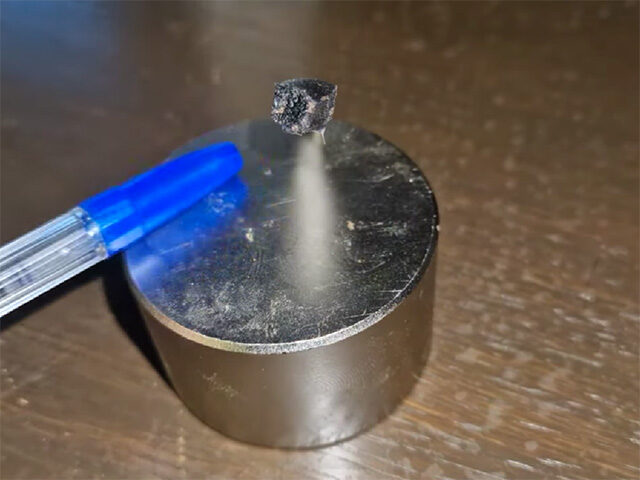Researchers in the United States and Europe this week dashed hopes of a major discovery that could have revolutionized our most advanced technology by determining that LK-99, a material created by a privately funded laboratory in South Korea, is not a room-temperature superconductor.
The Quantum Energy Research Center in Seoul caused a worldwide sensation in early August by claiming it had discovered a material that could serve as a superconductor without extremes of temperature and pressure.
Superconductive materials convey an electric charge with virtually no loss of energy and they create very powerful magnetic fields. Both of those features would be enormously useful, potentially making electronic devices much smaller, lighter, and faster than they already are, or making it possible to build commercially viable machines that depend on strong magnetic fields. Superconductors have been created in laboratory conditions before, but they require extremely cold temperatures and high pressures, which robs them of commercial applications.
The South Korean team sought to demonstrate their discovery with the most visually spectacular application of superconductive material: levitating a small object with magnetism. The video of the team apparently accomplishing this feat with a small sample of the LK-99 alloy in room-temperature conditions became a viral sensation.
Of course, all such claims must be rigorously validated. The South Korean Society of Superconductivity and Cryogenics voiced immediate skepticism, announcing the formation of a blue-ribbon academic panel to study the discovery. Research teams around the world began attempting to replicate the LK-99 experiment.
The results are in, and sadly, it appears LK-99 is not superconductive at all. Instead, the material contained impurities that lowered its electrical resistance and allowed it to generate a decently potent magnetic field. Pure LK-99, researchers say, is an insulator, not a conductor at all.
Nature spoke to researchers who said one of the “tells” was the way LK-99 could be held aloft by a magnet in the famous demonstration video, but it was not truly levitating – because if it was, the material could have been flipped and spun around with ease, like those flying skateboards everyone has been daydreaming about. A decent conventional magnet can produce the results seen in the famous LK-99 demonstration video, but a superconductor would have made that demo chip fly.
Some researchers also perked up when they saw the temperature data from the South Korean experiment because the most powerful magnetic effects were observed at precisely 104.8 degrees Centigrade, which happens to be the temperature at which copper sulfide becomes strongly magnetic. That kind of magnetism is nice, but not revolutionary.
Skeptics noted that after being heated to over 104ºC, the LK-99 sample displayed a strong drop in electrical resistance as it cooled, which might have misled the Quantum Energy Research Center team to believe they had a superconductor on their hands.
The scientists who debunked the LK-99 superconductor found their detective work invigorating and drew some valuable lessons from the entire affair. Forbes chronicled engineer Andrew McCalip becoming an overnight sensation on the Twitch streaming platform, whose top performers are usually video game players, as a rapt audience of thousands watched him trying to recreate the LK-99 experiment.
Public interest in science is always encouraging and researchers were pleased by the tremendous surge of interest in superconductors, a complex topic that really will change the world if anyone does manage to produce one that functions at room temperature and pressure.
Forbes mentioned predictions that superconductivity could save billions of dollars in electric power costs by making transmission lines more efficient, dramatically lower the cost of machines like MRI scanners, and make nuclear fusion commercially feasible. Physicist Casey Handmer added that superconductors would also make high-powered electrical systems generate far less heat, which would reduce the cost of building and operating them.
Another exciting thing about LK-99 during its brief moment in the sun was that duplicating its recipe was fairly cheap, and that will be a major feature of revolutionary superconductor technology – it must be reasonably priced compared to the less efficient conductive materials it replaces. LK-99 became such a merry but brief obsession among chemists and physicists because they could reproduce it so easily and test it themselves.
The scientists who debunked LK-99 praised its creators for doing a good job of documenting their experiment and making a serious claim that, unfortunately, did not quite pan out.
“You know, some guys made a discovery. They clearly didn’t understand completely what it was. But they took an optimistic view, and then presented a good lock of evidence so that people could look at it and judge for themselves. It’s not bullshit. It’s not obfuscation,” chief materials scientist David Larbalestier of the National High Magnetic Field Laboratory told Forbes.
A few physicists grumbled that the instructions for mixing LK-99 could have been a bit clearer, and the experiment could have been verified more carefully by the original researchers before they raised hopes around the world.
“A lot of the stuff early on was rushed and statements from all sides were unchecked. The social media, memes, etc., have been completely detrimental to progress in this field in my view,” Princeton University condensed matter theorist Andrei Bernevig told Physics World on Tuesday.
“I hope we never do science like this again,” Bernevig said.

COMMENTS
Please let us know if you're having issues with commenting.